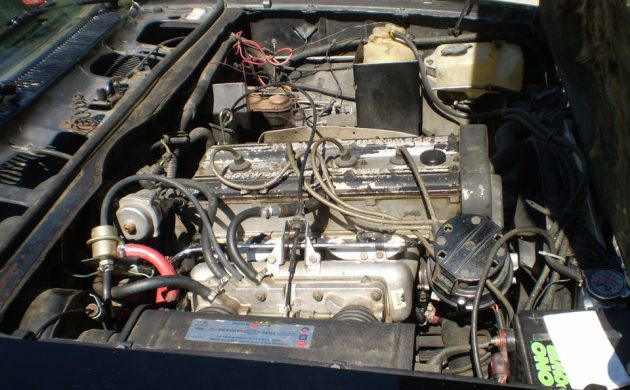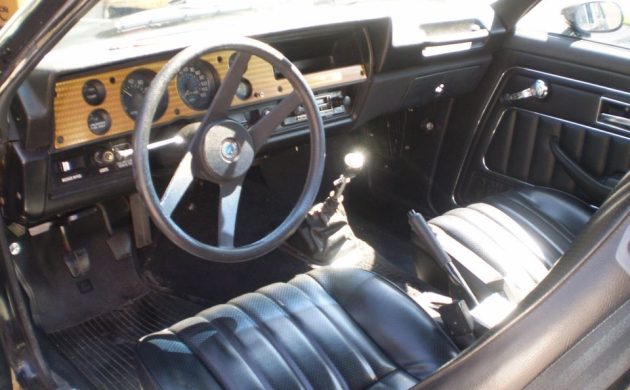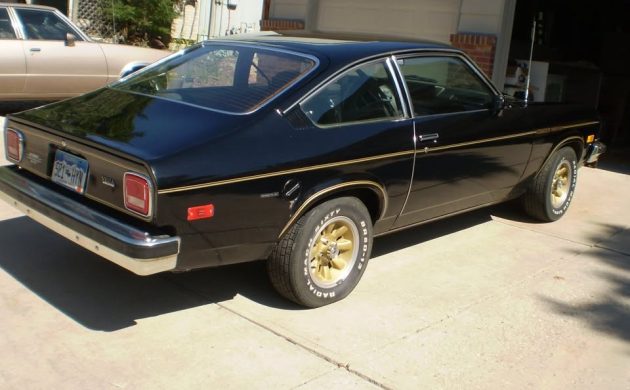The Cosworth Vega must deserve a prize for longest incubation before birth, becoming a gleam in the eyes of Chevrolet General Manager John DeLorean as soon as the first Vega took up residence on GM’s drawing boards. The Vega was to be GM’s answer to a flood of economy imports coming to US shores, but it was underpowered. DeLorean felt sales would benefit if a performance version could be sold alongside the grocery-getter. Discussions with Cosworth Engineering in England around a better engine commenced in 1969 – before the first Vega hit the showrooms in 1971. Experience building Formula One engines did not translate to production of a performance-oriented, two-liter four-cylinder for road use. For one thing, the blocks supplied by Chevrolet had a tendency to split. Later, during required 50,000-mile emissions testing, the engines burned up exhaust valves. (Apparently Chevrolet decided to retard the timing on the test engines, hoping to pass with a wide margin, and this contributed to their failure.) Meanwhile, gasoline was reformulated, forcing Cosworth’s engineers to downgrade the compression ratio repeatedly, until rather than the 185 hp promised by Chevrolet, the new car was delivered with only 110 hp on tap. Matters were made worse by poor sales results for the more pedestrian Vega, sullying the name in they eyes of consumers. These factors conspired to push the Cosworth Vega from a planned launch date of 1973 out to 1975. Despite its fraught beginnings, the Cosworth Vega has a small but loyal following among today’s collectors. If you’d like to join them, here on facebook Marketplace is a low-mileage 1975 example listed at $11,000. The car is located in Fort Collins, Colorado, and we owe thanks to T.J. for the tip.
The aluminum block in-line four-cylinder engine finally left Cosworth displacing 2 liters, with DOHC architecture and Bendix fuel injection. After all this, as noted, the output came to just 110 hp; reaching 60 mph took a leisurely 12 seconds. Granted, that was a marked improvement over the Vega “normale” at 75 hp. But it left Chevrolet’s dream of competing with BMW’s nifty little 2002 as just that – a dream. At least buyers got a four-speed manual (and later a five-speed) – never an automatic. Handling was fine, but the running joke among reviewers was that the car really couldn’t go fast enough to test the handling. This car runs and drives well; the odometer reads 73,000 miles, said to be original.
Given the engine delays, Chevrolet was able to overthink the Cosworth concept for years – and that they did, deciding the car’s cosmetics should be special. DeLorean declared that only one color scheme would be sold: black exterior, with gold accents (doesn’t that just sound like him) including the wheels, trim, striping, and engine-turned instrument panel. This interior is in good condition; the dash plate indicates that this is car number 1503, out of total production of 2061. In an era of nearly ubiquitous power and comfort options, power steering, power brakes, and air conditioning were not offered.
Despite its penurious specifications, the Cosworth Vega’s price was twice that of a regular Vega, and only a few hundred dollars shy of a base-spec Corvette, helping to explain the low production numbers. All that work, for just over 2000 cars! True, it wasn’t just the Cosworth that killed the Cosworth – the Vega’s introduction was charged with reliability issues which, though remedied later, didn’t help. Lest it seem that my viewpoint is too negative: I confess that as a lover of the weird and unwanted, these intrigue me. If I were in the market, this particular example would be high on my list.





Sharp looking cars.
If only… I liked these as well. Too bad about their tendency to rust. I wonder how that engine would tune up. Could you get 150 hp out of one or would it grenade? That would take it to another level.
You can get well over 150 hp out of these. It isn’t difficult, pretty basic actually (compression, cams, Webers, and it already comes with the header you are going to want to use). In period road race trim, they “could” be built to the high 200 hp level, but did not prove to be reliable at those levels. 150 is easy peasy.
best
bt
I’m with you, dude, except I’d substitute Borla fuel injection, which uses Weber-style throttle bodies for the Weber carburetors. Fuel injection offers better fuel control all across the rev range, and keeps the catalyst from melting due to a rich mixture. Of course, if you’re racing one of these, the catalyst is gone, LOL!
In 1975 the price of a Corvette Coupe – $6.810, a Corvette Convertible – $6,550….
The Cost of a Cosworth Vega – $5,916 – double the price of a standard Vega.
Explains the low production numbers, but I’m betting these were a kick to drive, they were faster than the Corvette, but couldn’t reach the higher top speed of the Corvette.
In typical GM fashion. The Cosworth Vega was too little, too late.
I don’t know, GM always innovated faster than anyone else, Hydramatic, Corvair, Aluminum 215 V-8 with Turbo charger, Toronado FWD, Fiero, Cadillac Seville, Vortec engine designs
True, but then GM could never quite make those innovations work in production, for whatever reason. They either stopped making them just before or just as the Engineers got the bugs worked out, or decided that they cost too much, so the bean counters, er, accountants killed them. Then when the foreign competition was able to provide better performance both on the road and at the gas pump for a lower price, GM was so far behind, that they’re still trying to catch up, fifty (50) years after the fact!
Living in south Florida in the ’70s with a ’72 Chevy Blazer we were at the dealership quite often. What we noticed was a supply of Cosworths sitting for long periods of time. Sales folks said when customers found out about no AC available they just walked out.
My folks never got AC in their cars back then, but we lived in the northeast. I can’t imagine not having it in Florida! That dealer should have swapped with someone up north.
Missing and no mention of the air injection tubes (4 chrome tubes across the top of engine), I would suspect that this would not pass CA smog inspection, and could not be registered in CA.
’75 and older are exempt.
Thank you, I wrongly thought 1974. Good to know now.
Exempt from testing only. By law they are still required, one day California will get around to rolling back emissions testing back to 1966 model year.
Steve R
I owned a 1974 Vega GT. I bought it used in 1976. I loved the shape and the forward opening hood. My first car was a 1971 Plymouth Cricket. Comparing the 2 cars the Vega was a rocket. Lol. The GT had all gauges and according to the temperature it never over heated, but I had to have 3 new heads in 12 months. When I needed a 4th head GM refused to replace it, saying I was abusing the car. I was extremely busy at the time and never read or heard of the Vega’s engine problems. In 1977 I traded the Vega for a Chevy Nova. Several friends were surprised I stayed with GM
It makes sense, the Nova was an older, more conventional car, and whatever kinks it had were worked out before the first Vega hit the lot.
One of those collectors lives in my neighborhood. He’s got about 5 in his yard!
I saw a vega’s dash rusting out. I wouldn’t touch one. A co worker had a Monza with a 4 spd that was fun but slow. They had worked the bugs out but too little too late by then. They’re even rarer now.
Some misconceptions and clarifications about this car.
Compression in the Formula 2 racing engine was 12:1. That engine made 260 hp.
The street version was originally rated at 170 gross hp with Weber side drafts in 1971. This was the same 8.5 compression engine the public eventually got. The drop to 110hp was twofold. 1. The conversion from 170 gross to 140 net hp (no change). 2. The add of a catalytic converter (it was 1975 by then).
110 was STILL more hp than a base BMW 2002. These were around 10 second 0-60 cars. Still faster than most Camaros and Firebirds in 1975. Remove the catalytic converter and these engines breath much better (they are tuned for very high rpm). 150 hp at the flywheel and 120 rwhp is about correct in that setup. Replace the FI with dual Webers and you are back to 170 gross.
These are super good handling cars and a firecracker to drive.
These were what the Vega should have been, and could have been from the start! If only the base engine had been designed and built properly, this would have been a nice upgrade from the base Vega. I for the life of me still don’t understand why GM built an engine with an aluminum block, but a cast iron cylinder head, for example! Stupid! But the stock motor had such a bad reputation by then, that trying to sell a sportier version of a dog would have been a tough sell in any case. But the $5900 price tag without power steering, power brakes or air conditioning was the final straw, and made them dealer lot queens, sitting unsold, even in the small quantities (5000 cars) that were finally built. In that sense, they were much like the Dodge Daytona/Plymouth Superbird were when they were new just five (5) years earlier! Hopefully, these will get a little more respect as collector cars now. Maybe not six figure price tags like the Mopar twins, but as affordable classics that should be recognized as a significant achievement in their own right.
As for the engine “grenading”, these engines use forged steel connecting rods and crank and forged aluminum pistons. They are fully balanced and were hand assembled in a clean room lab. They are internally the same engine as the Formula 2 engine. They have a 7500 rpm redline with an open exhaust. I have seen very few engines made by anyone rev like these.
Good body, bad motor!
Only the base cars had bad motors! These actually held up well, because Cosworth did what GM should have done from the start, and used iron cylinder liners (sleeves), forged connecting rods, a forged crank, and an aluminum cylinder head, in place of the stock Vega’s iron head and Nikasil plated cylinder bores! The only way the Cosworth Vega could have been better would have been if it had an Independent Rear Suspension (IRS) and rear disk brakes to go with the hot motor, in place of the solid rear axle and rear drum brakes, LOL!
Let me set a few things straight, I owned one of these, black, 1975. The engine was NOT steel lined with sleeves, although there was a company in TN which would do that….the internals were strong, but the block had too little silicon, and the bores wore quickly.
The 0 to 60 time was around 9 seconds, gas mileage, driven 70 mph or so was in the high teens, it had a high numeric rear ratio, 4:11 or 3.91.
It used the rear suspension of the Monza, different from the standard Vega, but not great, my 75 Opel 1900 (Ascona) was better in every way. I autocrossed both of them, the Opel was always the winner. They were not good sellers, I bought mine in 1977 for HALF the list price, with 9000 miles on it, from a Chevy dealer .
Above comment by Jason V
I like these, but they were doomed from the start! At a $5900 list price, you could buy a fully loaded TransAm or Z28 for what these cost, and have about $600 left over! I admire the fact that this was GM’s first 16-valve, four-cylinder, all-aluminum engine, and the first GM four-cylinder engine to receive Electronic Fuel Injection (EFI), a fact that escapes most people’s notice. Ed Cole and John DeLorean were trying something new, and I applaud them for that, but by the time the cars made their way through the GM bureaucracy, they were but a mere shell of what they could have been. Like so many things GM touched at the time, they took the potentially great and made it mediocre at best, to Godawful at worst! If the Vega had been given the money and resources to be designed properly, things might have been different, but trying to turn the Vega, an already deeply flawed automobile, into a performance car, was a fool’s errand!
I didn’t know Cosworth sleeved the cylinders on these and substituted an aluminum head. That and the other better engine components explain why the car was so expensive. The standard Vega was a real POS. My parents bought one new and the dealer had to replace the engine with quite low mileage. They were not well built at the Lordstown factory.
In 1975 I bought my first new car, a Camaro Type LT, nicely equipped for $5096. I liked the looks of the Vega GT but the complaints of engine issues were rampant. The Cosworth was a nice looking and interesting alternative but couldn’t justify the price tag especially without AC and an automatic.
And your Camaro LT was the equivalent trim level to the Firebird Formula, you paid more for a TransAm or Z28! So you could still buy a top-of-the-line F-Body car, and still paid less than the list price of a Cosworth Vega, LOL!